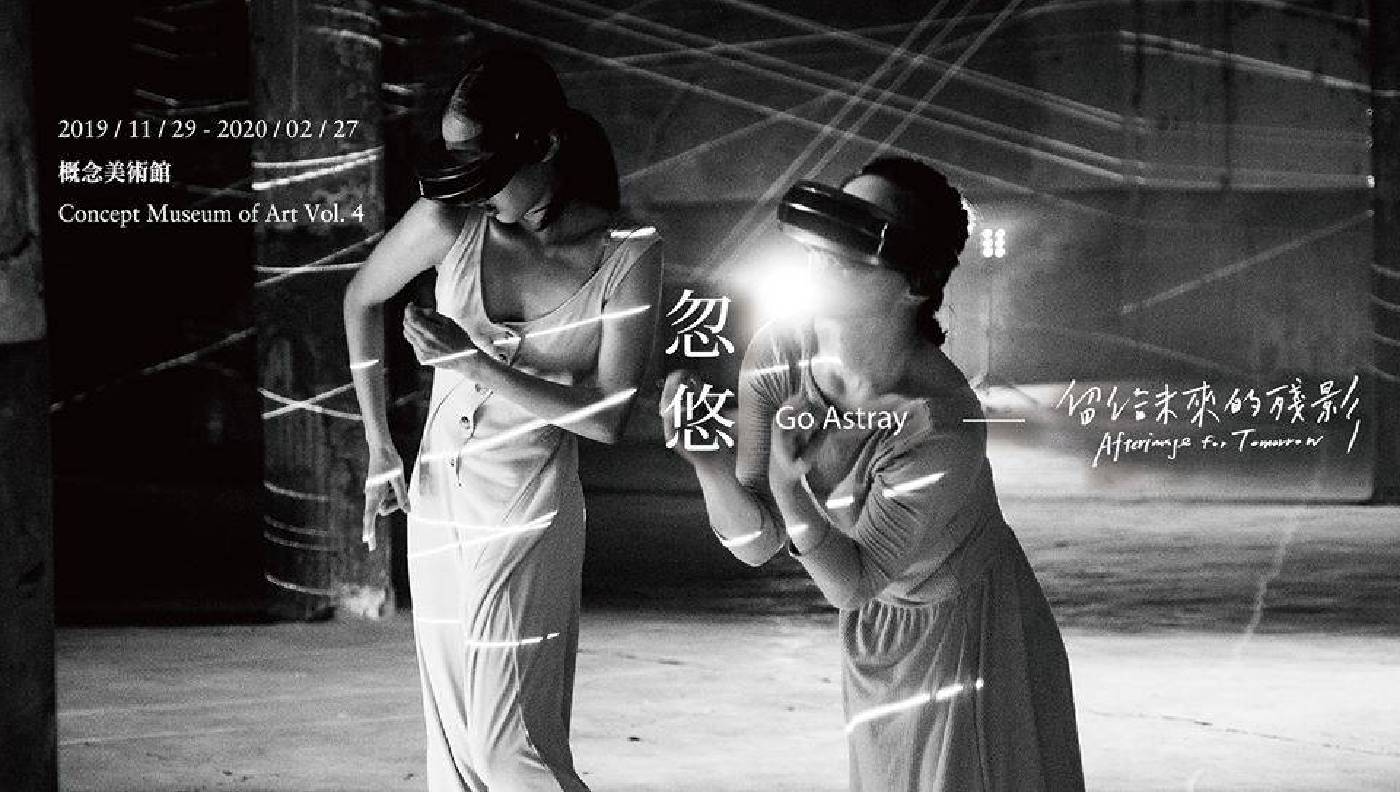台灣數位藝術中心
【《忽悠—留給未來的殘影》 Go Astray – Afterimage for Tomorrow】

-
展期
日期:2019-11-29 ~ 2020-02-27
-
地點
台北市士林區中山北路六段431-1號B1
-
參展藝術家
陳芯宜、周書毅
-
策展論述 Curatorial Statement / 邱誌勇 Chui Chih-Yung
「忽悠」—意旨「晃動」、「搖擺」,是使人飄忽不定的狀態或心態。
人死後的靈魂終歸何處?記憶是否復存?一直以來都是宗教世界與科幻領域被議論的命題;而在閾限之間,魄體幻化為飄忽游離的狀態,又應如何被具體描述。《留給未來的殘影》以實現性手法、與舞者跨界共創的策略,使虛擬實境成為當代尖端科技身體義肢(prostheses)的附加,允諾一種另類的、「脫離身體」的經驗,使人一生的記憶圖景得已藉由科技的持存,體現一個「感性的科技轉向」。虛擬實境不僅是身體的延伸,它提供了更多的自由、投入純粹意識的未來;虛擬影像的模仿是不斷的、一而再的在主體面前呈現出來。
作為VR電影,《留給未來的殘影》以沉浸觀看形式,述說著男子甦醒於某個意識層面,其所見、所聽、所感的究竟是記憶?是夢境?是虛擬實景?抑或是死前的記憶回返?文本中,主角透過「生前記憶續存服務」人們神經元中的記憶碎片顯為殘影,並在一根火柴的時間之內,複訪生命中的那個曾經。於此之中,空間不再具有理性,時間亦失去邏輯序次。虛擬實境的創作實踐之所以能引發觀眾對作品的情感與哲學性內容、對文本的敘事與主題做出熱烈且全面性的回應,乃是因為觀者身處於影像景觀世界之內,窮盡所有現場表演中的感官可能性,並體現於一系列空間、聲音、時延、影像間,建立出一套獨特的屬於「它自己的世界」(‘in-its-own-world’-ness)。
以舞蹈闡述記憶中超脫語言描繪的意境;用影像記錄舞蹈中表意魂魄游離的飄忽,導演陳芯宜與編舞家周書毅共同創作的《留給未來的殘影》更超越了「舞蹈錄像」(dance video)的表現形式,使觀者遊牧於三根火材燃燒時所顯像的記憶殘影,通過游離於奇點(singularities)的空間跳耀,遊牧於一幕幕影像世界,不斷地游走,卻不斷地分裂。身處於此「臟器式表演」(visceral performance)之中,以虛擬科技、憑影像敘事、借舞蹈身體,激起觀眾極為內裡的、無法以言語來表達的、多愁善感的感知經驗;同時也描述強烈的情感以及觀眾因內心騷亂所引起的生理反應,促使個體(觀眾)意識到其頭顱與肉身開始產生融合與聚變。
化為概念美術館中的科技藝術展,「忽悠—留給未來的殘影」邀請觀者在「言下之意」與「絃外之音」(literal and lateral)之間轉換,以科技連結身體,召喚記憶的殘影,體驗煙滅前的忽悠。
“Go Astray” refers to the state of mind where people are distracted or drifted, acting in “wandering” and “swaying.”
Where does the spirit go after death? Are memories still there? How to describe this sensory threshold where body and soul are disassociated from each other, distracted, and drifted? Afterimage for Tomorrow accomplishes the strategy of interdisciplinary artwork, collaborating with dancer, and making Virtual Reality become modern supplementary prostheses. It promises a disembodied experience, and lifetime memories and images can therefore be possessed and stored with the aid of technology which manifests emotional technological shift.
As a VR film, Afterimage for Tomorrow is an immersive experience recounting a man awakens in somewhere of his consciousness. What he sees, hears, and feels, are these just memories? Is it a dream? A virtual landscape? Or a flashback before death? In the context, with Afterlife Memory Trust, memories fragment in human neurons are presented as afterimages. The protagonist revisits the specific point of his life in a light time. Herewithin, space is no longer rational, and time is not in chronological order.
By means of dance, it recounts the ineffable notion of memories. Through the medium of image, it records the dance that symbolizes the drifting state of disassociated body and soul. The collaboration of Afterimage for Tomorrow between the director Singing CHEN and the choreographer Shu-Yi CHOU surpasses the expressive form of dance video. Audience as nomad wander through afterimage of memories which appear when the 3 matches light up. Thus, Audience travel through spaces disassociated around singularities, and wander through scenes of visualized world. They are lingering in the world which is constantly pulled apart. In the visceral performance, by means of virtual technology, narrative film, and physical dance, audience is stirred up with ineffable and sentimental perception coming from deep inside.
Transformed into digital art collection of the Concept Museum of Art, Go Astray -Afterimage for Tomorrow invites audience to shift between literal and lateral, integrate technology with their bodies, call for the flashback of memories, and experience the state of going astray before everything is evaporating.
---
藝術家自述 Artist's Statement
陳芯宜
這是我第一次製作VR影片,在構思與研究的過程中,不斷想著「VR要帶給人類的是什麼?人類的感官如何被拓展與改變?真實又是什麼?」,以及「在人類文明歷史中,從聲音、圖像、語言、文字、影像…到虛擬媒體,所留下的紀錄,有多少得以穿越時間與空間,來到我們(或未來)的眼前?」希望透過這些思索,將「形式/媒體」與「內容的核心」合而為一。於是影片設定了一個可以上傳記憶意識的未來世界,藉由周書毅的舞蹈,捕捉在死亡之前、彌留之際無以名狀的情緒。也藉此討論什麼東西值得留下?未來的VR是否直接就在我們的腦內?甚而後設地看待這段舞、這段VR,是否能穿越?或是一切都將化為塵土。
Singing CHEN
This is my first VR video. During the research and brainstorming process, I kept wondering questions like, what has VR brought to us? How does VR extend and change human senses? What is reality hereafter? I was also wondering, in the history of civilization, how many vestige of sound, graphic, language, characters, image, and virtual media get to travel through time and space, and become visible to us (or to the future)? With these pondering and weighing, I try to integrate form/medium with the core value of content. Thus, this film is set upon a futuristic world where memories and consciousness can be uploaded. Through Shu-Yi CHOU’s choreography, it captures the ineffable emotions as one lingering at the edge of death. Also, it is to discuss what’s worth remaining. In the future, could VR be rooted inside of our brain? If we put this VR film of dance into meta-thinking, could this work traverse time? Or on the contrary, everything would turn to ashes in the end.
《忽悠—留給未來的殘影》 Go Astray – Afterimage for Tomorrow
● 策展人 Curator:邱誌勇 Chih-Yung CHIU
● 藝術家 Artist:陳芯宜 Singing CHEN、周書毅 Shu Yi CHOU
● 舞者 Dancer:潘柏伶 Bo Ling PAN、方妤婷 Yu Ting FANG、葉王洲 Wang Chou YEN、楊雅鈞 Ya Chun YANG、王甯 Ning WANG、林修瑜 Hsiu Yu LIN、王筑樺 Chu Hua WANG、田懿葳 Yi Wei TIEN、余建宏 Chien Hung YU、陳欣瑜 Hsin Yu CHEN、楊奇殷 Qi Yin YANG
● 出品單位 Presented by:高雄市電影館 Kaohsiung Film Archive、Funqiue VR Studio、行者影像文化有限公司 The Walkers Films Ltd.
● 特別感謝 Special Thanks:國家文化藝術基金會 National Culture and Arts Foundation
